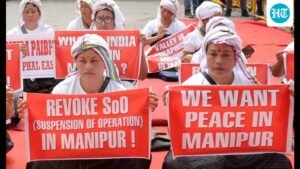
Gurugram: From upscale condominiums to rural stretches, nearly 900,000 people from across Gurugram district braved the heat and serpentine queues to exercise their franchise in the high-octane electoral contest in Haryana on Saturday.

According to provisional figures released by the district administration, the turnout appeared to have taken a hit – a total of 861,092 voters exercised their right to vote this year, compared to 1.1 million voters in the 2019 assembly election.
This meant that the provisional turnout at 10pm stood at 57.9%, down from the 64.6% figure in 2019, according to Election Commission of India (ECI) data. To be sure, this number is likely to be revised upward when the Election Commission releases final figures.
The district has a total of 1,504,949 registered voters.
Officials said that assembly polls were held peacefully in Gurugram district, barring sporadic clashes in Nuh, where nine people were injured. Polling stations operated smoothly across the four constituencies — Gurgaon, Badshahpur, Pataudi and Sohna.
“Polling began at 7am and queues started formed early. By the end of the day, a significant portion of the electorate had voted, but the official final turnout will be confirmed once polling parties submit their final reports,” said Gurugram deputy commissioner Nishant Kumar Yadav.
According to provisional figures, the Gurgaon constituency witnessed 226,918 voters exercising their franchise, a 51.2% turnout of the total 443,102 voters.
In Badshahpur constituency, 281,510 voters cast their ballots, representing 54% of the 520,958 registered voters. Pataudi (SC) recorded a voter turnout of 61.4%, with 156,323 voters out of 254,780 participating. The highest voter turnout was recorded in Sohna constituency, where 68.6% voters, or 196,341 people out of 286,119 registered voters, participated in the election.
After conclusion of voting, the polling parties from all four constituencies began arriving at the Government Girls College in Sector 14, Gurugram, where the Electronic Voting Machines (EVMs) will be stored securely till counting on October 8.
“All candidates’ representatives can monitor the security of the EVMs through the control room,” Yadav added.
The district administration took extensive measures to ensure that the polling process was transparent and that polling stations across the four constituencies were equipped with the necessary infrastructure. No incidents of violence or disruptions were reported.
Though voter turnout was lower than expected, many first-time voters expressed happiness at being able to cast their ballots. Senior citizens, on the other hand, highlighted healthcare facilities as their primary concern when voting. Women voters, particularly at pink booths, expressed their desire for improved safety, security, and development in their areas.
Low voter turnout in condos
The fall in turnout compared to 2019 reflected a broader trend of voter disengagement across urban areas, as seen in the lower-than-expected participation from Gurugram’s condominiums, which were equipped with polling stations within the premises in an effort to seek greater involvement.
As of 6pm, 57.2% of eligible voters had cast their ballots across the Gurugram. The Gurugram administration had set up 126 polling booths in high-rise apartments and condominiums. However, the ease of access did not translate into a higher turnout.
Several reasons have been identified for the low turnout by residents and officials.
Amit Jindal, RWA president of Vipul Greens in Sector 48, pointed out that many residents did not see a compelling reason to vote. “There’s no motivation to vote when no party addresses the real issues of development in our city,” Jindal said.
Gauri Sarin, founder of Making Model Gurugram, explained that many high-rise residents feel disconnected from the local political landscape. “Condo residents are often non-locals and view assembly elections as a battle of caste politics. There was very little engagement with candidates, even during meetups. The apathy was evident,” she said. Sarin also noted that internal conflicts within RWAs further contributed to voter disengagement.
The extended holiday weekend played a significant role in reducing voter turnout, other residents said. With the timing of the elections conflicting with festivities, many residents opted to travel instead of staying in to vote.
Another key factor contributing to the reduced participation was widespread dissatisfaction with the state of the city’s infrastructure. Poor roads, frequent traffic jams, and unresolved civic issues have frustrated many residents. Some chose not to vote as a means of protesting the lack of attention to these long-standing concerns.
Gaurav Tuteja, a resident of Imperial Gardens in Sector 102, said, “The RWA didn’t take any initiative to mobilize voters. People here don’t care about the Haryana elections because there are no facilities in our sector.”
Deputy commissioner Nishant Kumar Yadav expressed his concern over the low turnout, especially among residents of high-rise condominiums. “It is something we need to analyze, why high-rises did not vote as much as expected. Probably the extended weekend played a role, but it is sad to see such low participation. We set up polling booths inside these communities to make it easier for people to vote, yet many did not turn up,” Yadav stated.
While urban voters remained largely disinterested, the rural vote was driven by different factors, including caste equations, local negotiations, and promises of development. Rural voters may have been swayed by anti-incumbency sentiments or promises of freebies offered by candidates. The urban-rural divide was clear, with rural voters often having more at stake in the elections compared to the disillusioned urban population.







